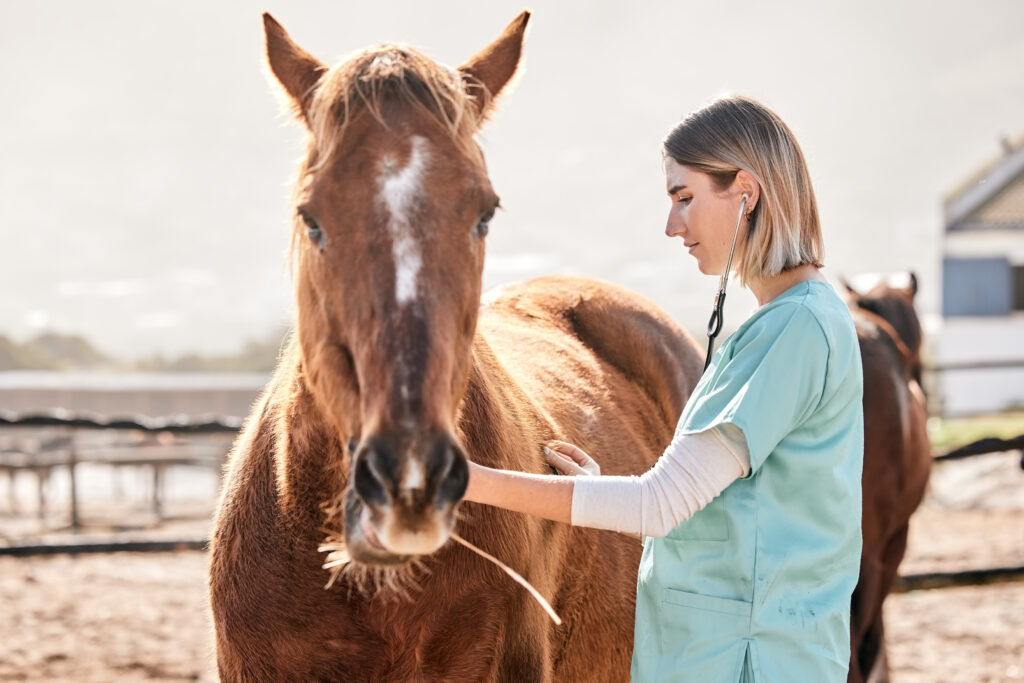
In this episode, Stacie Boswell, DVM, large animal surgeon at Hardaway Veterinary Hospital, in Belgrade, Montana, joined us to discuss Fear Free veterinary care, an approach to veterinary practice that prioritizes the animal’s physical and mental well-being.
What Is Fear Free Veterinary Care?
Fear Free is an educational platform founded in 2016 by Dr. Marty Becker, a small animal practitioner who sought to alleviate fear, stress, and anxiety in pets by educating the people who care for them. Since gaining traction in the small animal world, Fear Free has expanded to include equine modules. The platform has information available for everyone who is involved in veterinary care, including veterinarians and staff. There is also a client-facing website.
Boswell described the three core concepts of Fear Free: touch gradient, gentle control, and considerate approach. “We can apply those three things to all species,” she said.
Touch gradient involves touching the horse in a nonsensitive area, such as the wither or shoulder, and maintaining contact with the horse’s body as you work on them. Boswell likes to maintain contact with the horse as she runs her hand across their body to position her stethoscope. Touch gradient is also applicable when lifting the horse’s leg or introducing them to clippers. The approach is intended to help avoid the startle response in the animal.
Boswell said considerate approach is the most difficult core concept to define, because it encompasses everything. Essentially, considerate approach involves making everything better from the horse’s perspective. Practitioners should look at how the horse responds to all inputs from the environment, considering all five senses. Does the medicine taste bad? What does the clinic look or smell like to the horse, and how can we make it better? What does this touch feel like to the patient? Boswell gave the example of using a 22-gauge needle for vaccines rather than an 18-gauge needle to improve the patient’s comfort.
Gentle control involves using the minimum amount of restraint necessary to do the job. “In the context of small animals that comes across as you don’t need to scruff every cat. In the equine space you don’t need to twitch every single horse,” Boswell said. Instead, Boswell might use stocks or a bucket of feed to help keep a nervous horse still.
Fear Free in a Clinic Environment
Boswell discussed implementing Fear Free practices in a clinic setting, where horses are in an unfamiliar environment. In the clinic setting, Boswell likes to distinguish between medical needs, such as severe colic or another serious emergency, and medical wants, such as getting a Coggins test to go to a horse show. If the horse is nervous in the clinic environment, Boswell might recommend postponing non-emergent appointments for a week or two to make time for more training.
Boswell also recommends owners bring two horses into the clinic for routine work to provide companionship. When two horses arrive together, she keeps them within sight and vocal range of each other.
Fear Free in a Field Environment
While field settings are often uncontrolled compared to a clinic, the horse usually feels more comfortable in the familiar environment, which is beneficial. If the horse lives in a 50-acre pasture with other horses, Boswell said she won’t necessarily bring the horse into the barn away from its friends. Instead, she might work on the horse in the pasture. If the horse must come into the barn, she will bring a second horse to keep it company. Boswell also makes friends with her patients and talks openly with owners about what has worked for their horses in the past.
Client Education
“Client education is a huge component of Fear Free,” said Boswell. She explained that it is important to educate owners on animal body language, such as how a horse is pinning its ears or how its nostril is shaped.
Boswell said most owners are very appreciative of her approach to veterinary care, and some of her clients come to her specifically for Fear Free techniques.
Fear Free Resources
To learn more about Fear Free veterinary care, Boswell recommends visiting fearfreepets.com/webinars. Many of the webinars are free, and while most are about small animals, they can provide more insight into the Fear Free approach. Practitioners can also direct owners to the client-facing website at fearfreehappyhomes.com so they can learn more about the approach.
About Dr. Stacie Boswell
Stacie Boswell, DVM, graduated from the Virginia-Maryland College of Veterinary Medicine and completed an internship at North Carolina State University. From there, she was a postdoctoral research associate in the Comparative Orthopedic Laboratory at Cornell University and then completed a large animal surgery residency at the University of Tennessee. The intense specialty training in surgery and equine lameness evaluation and treatment culminated in qualifying for and passing a rigorous examination from the American College of Veterinary Surgeons, thus earning Diplomat status as a Large Animal Surgeon.
Boswell is driven to make horses’ lives better through both physical and mental well-being, and she has a strong interest in equine behavior. Working with patients in a low-stress way led Boswell to be a collaborative author for Equine Fear Free modules. Boswell is also the author of The Ultimate Guide for Horses in Need: Care, Training, and Rehabilitation for Rescues, Purchases, and Adoptions, published by Horse and Rider Books.
You can contact Boswell at stacie@stacieboswell.com.








